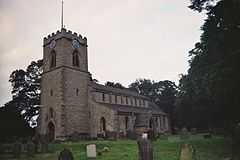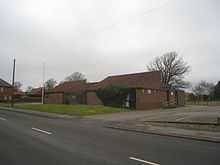Scawby
Not to be confused with Scawsby
| Scawby | |
 Church of St Hybald, Scawby |
|
 Scawby |
|
| Population | 2,277 (2001) |
|---|---|
| OS grid reference | SE968053 |
| – London | 145 mi (233 km) S |
| District | North Lincolnshire |
| Shire county | Lincolnshire |
| Region | East Midlands |
| Country | England |
| Sovereign state | United Kingdom |
| Post town | BRIGG |
| Postcode district | DN20 |
| Police | Lincolnshire |
| Fire | Lincolnshire |
| Ambulance | East Midlands |
| EU Parliament | East Midlands |
| UK Parliament | Gainsborough |
|
|
Coordinates: 53°32′09″N 0°32′24″W / 53.535740°N 0.540009°W
Scawby is a village and civil parish in North Lincolnshire, England.[1] It is situated 2 miles (3 km) south-west from Brigg, and just east from the A15 road, and south from the M180 motorway. According to the 2001 Census, Scawby population was 2,277.
The village is noted for the Nelthorpe family who owned the manor and lived at Scawby Hall.[2] Sir John Nelthorpe founded Brigg Grammar School in 1669.[3]
Sturton was formerly a separate hamlet a little to the south of Scawby, but development of the land between the two has incorporated the settlement into the main village. Scawby Brook, situated to the east just outside Brigg, is also partly within the parish. Also in the parish, to the west of the main village, is the roadside hamlet of Greetwell on the B1398 road.[3]
History

Neolithic and Romano-British archaeological finds indicate a long history of habitation.[4][5][6] Two mosaic floors of a possible Roman villa were found at Sturton Farm in 1816.[7]
Scawby is mentioned seven times in the Domesday Book, as "Scallebi" or "Scalebi", with a total of 34 households.[8]
Scawby Hall is thought to date from 1603, with an 18th-century frontage and windows, and 19th-century crenellations.[2][9]
Scawby Mill, a brick-built tower mill, was opened about 1829, but the present tower was built as part of a house after the original tower collapsed during renovation work in 1994.[10]
Scawby railway station, to the south of the village, opened in 1848, and closed 120 years later. The line is still open.[11]
The church of St Hybald is dedicated to a 7th-century Saxon of that name. It is built in the Early English style, but was substantially rebuilt in 1843 by William Adams Nicholson, and in 1870 by James Fowler of Louth. The tower is original, of the 15th century, with 13th-century work at the base.[12][13]
There was a Methodist chapel in the village until August 2012. The Barton and Brigg circuit still operates a chapel in nearby Hibaldstow.[14][15]
Community

An old school building is next to the church. There is a village pump, telephone box, a post office and village shop, a primary school, the Sutton Arms public house, a fish and chip shop and a newsagent.
Scawby bus connections are to Brigg and Scunthorpe.[1][17]
The ecclessiastical parish is Scawby and Redbourne, part of the Scawby, Redbourne and Hibaldstow group of the Deanery of Yarborough. The Incumbent is The Revd David Eames.[18][19]
The village hall committee dates back to March 1921, when it was agreed to purchase a hut for community use in the village. In 1967 this was replaced by a brick building with views of open countryside.[16]
Scawby is home to local Quiz team "Dobbin" who defeated The Eggheads in 2011.
References
- ↑ 1.0 1.1 "Parish web site". Scrawby Parish Council. Retrieved 23 March 2013.
- ↑ 2.0 2.1 2.2 "Scawby Hall". Retrieved 25 June 2011.
- ↑ 3.0 3.1 "Scawby Local History Pack". North Lincolnshire Council. Retrieved 23 March 2013.
- ↑ Historic England. "Neolithic Axe (63330 )". PastScape. Retrieved 25 March 2013.
- ↑ Historic England. "Neolithic and Roman fragments (63349 )". PastScape. Retrieved 25 March 2013.
- ↑ Historic England. "cropmarks and Roman building materials (63314 )". PastScape. Retrieved 25 March 2013.
- ↑ Historic England. "Mosaic floors (63469 )". PastScape. Retrieved 25 March 2013.
- ↑ "Scallebi". Domesday Map web site. Retrieved 23 March 2013.
- ↑ Pevsner, N; Harris, J (1964). Lincolnshire. the Buildings of England. p. 352.
- ↑ Historic England. "Tower Mill (497799 )". PastScape. Retrieved 25 March 2013.
- ↑ Historic England. "Scawby and Hibaldstow railway station (498371 )". PastScape. Retrieved 25 March 2013.
- ↑ Pevsner, N; Harris, J (1964). Lincolnshire. the Buildings of England. pp. 351–2.
- ↑ Historic England. "Church of St Hybald (Grade II*) (1083718)". National Heritage List for England. Retrieved 23 March 2013.
- ↑ "closure of Scawby chapel". Methodist church, Barton and Brigg circuit. Retrieved 23 March 2012.
- ↑ "Hibaldstow chapel". Retrieved 23 March 2012.
- ↑ 16.0 16.1 "Village Hall history". Retrieved 23 March 2012.
- ↑ "Housing Needs survey" (PDF). North Lincolnshire council. 2.05,2.06. Retrieved 23 March 2013.
- ↑ "Scawby & Redbourne P C C". Diocese of Lincoln. Retrieved 23 March 2013.
- ↑ "Church web site". Retrieved 23 March 2013.
External links
 Media related to Scawby at Wikimedia Commons
Media related to Scawby at Wikimedia Commons- "Scawby", Genuki.org.uk
- Scawby Academy Primary School
- "Scawby Primary School", Ofsted school inspection reports
| ||||||||||||||||||||||